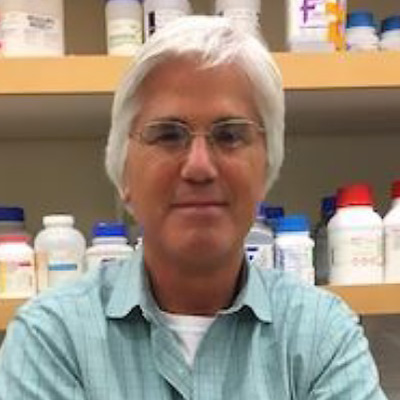2025 Grant Awardee Research Summaries
Young Investigator Awards

2nd Year Update
Preclinical evaluation of semaglutide for reduction of opioid craving and withdrawal
Cassie Moore, Ph.D., Johns Hopkins University School of Medicine
The United States continues to face a devastating opioid epidemic, underscoring the urgent need for new, effective treatments for opioid use disorder (OUD). Standard care for OUD often involves tapering individuals off nonmedical opioids such as fentanyl and heroin. However, after chronic opioid use, abstinence can trigger severe withdrawal symptoms and intense cravings, which frequently lead to relapse. Current medications used to treat withdrawal symptoms and reduce opioid craving are opioid agonists such as methadone and buprenorphine, and while effective for some, many patients request non-opioid treatment alternatives. There has been increasing interest in the FDA-approved GLP-1 agonist semaglutide (Ozempic, Wegovy), which is approved for the treatment of diabetes and weight loss, but may also have beneficial effects for reducing alcohol and drug intake. In our CAN-funded study, we are testing whether GLP-1 agonists can reduce opioid cravings and withdrawal symptoms in a rat model as a critical step in the development of these medications for OUD. Our preliminary findings suggest that semaglutide can reduce drug-seeking behavior (as measured by the expression of conditioned place preference) for low opioid doses, although this effect diminishes at higher opioid doses. Investigations are ongoing into the underlying mechanisms of this dose-dependent outcome. Importantly, when administered during acute opioid withdrawal, the GLP-1 agonist semaglutide did not worsen withdrawal symptoms, and tended to reduce them, a promising finding for clinical translation. During our second year of CAN support, we will will build on these findings by testing semaglutide’s effects during relapse and comparing its efficacy to Tirzepatide (Mounjaro, Zepbound), a dual Gastric Inhibitory Polypeptide (GIP) /GLP-1 receptor co-agonist that may have added benefit over GLP-1 agonists. This project will provide crucial insights into how GLP-1-based medications influence opioid reward and craving and will guide clinical collaborators in designing optimal dosing strategies for future human trials.

1st Year Summary
Semaglutide as Adjuvant to Medication-Managed OUD Care: A Novel Pilot Study
Jessica L. Olivares, Kathryn A. Cunningham, N. Miles Farr and Carlos R. Dostal Center for Addiction Sciences and Therapeutics (CAST) University of Texas Medical Branch, Galveston, Tx
The opioid crisis continues to devastate communities across the U.S., and while overdose deaths declined by 24% in 2024, 87,000 lives were still lost. In Galveston County, overdose rates exceed those of larger Texas counties on a per capita basis. Access to treatment remains a major barrier, as Texas ranks last in mental health care accessibility, with only 4% of individuals with substance use disorder (SUD) receiving treatment. Recognizing this urgent need, we established the Galveston Secure Against Fentanyl Emergency (G-SAFE) Clinic, a partnership between the University of Texas Medical Branch (UTMB) and St. Vincent’s Hope Clinic, to provide evidence-based treatment for individuals who are uninsured, underinsured, or experiencing homelessness. Since its launch, G-SAFE has treated 168 patients, with 78% diagnosed with opioid use disorder (OUD). Our approach, centered on trust and patient-provider relationships, has already led to significant reductions in drug use severity and depression. Medication-assisted treatment (MAT) with buprenorphine is a proven method for reducing overdose risk and supporting long-term recovery. However, many patients struggle with cravings and relapse, particularly in the early stages of treatment. Semaglutide, a medication originally developed for diabetes and weight management, has shown promise in reducing cravings and improving outcomes in individuals with substance use disorders. This study aims to explore whether semaglutide, when used alongside buprenorphine, can enhance treatment adherence, reduce opioid cravings, and improve overall well-being.
We will conduct a six-month clinical trial at G-SAFE, enrolling 40 participants who will receive either standard buprenorphine treatment or buprenorphine combined with semaglutide. We will monitor illicit drug use, treatment adherence, and patient-reported quality of life to assess the effectiveness of semaglutide in supporting recovery. Additionally, we will evaluate how trust in providers and stigma around MAT influence treatment outcomes. If successful, this study could pave the way for a larger trial and expand treatment options for people struggling with opioid addiction. By improving retention and addressing systemic barriers, our work has the potential to transform SUD care in Galveston County and beyond.
Innovation Awards

CS-1103 and its potential to treat fentanyl overdose
Cathy Cahill, P.h.D., UCLA
There are 2 aims for this project. But the overall purpose is to advance the clinical development of a novel drug for treating OUD that has shown promise not to precipitate withdrawal, and to have faster bridging to buprenorphine treatment to manage withdrawal.
One of the biggest issues in the emergency department is that patients with a fentanyl overdose go through significant sickness symptoms due to administration of naloxone (Narcan) to reverse respiratory depression. Our drug (Clear Scientific CS-1103) does not cause withdrawal like naloxone, yet rapidly reverses respiratory depression by binding to fentanyl and eliminating it from the body. Similar to naloxone, buprenorphine can also precipitate withdrawal if given in the emergency department when a patient still has fentanyl in their body. This is due to its pharmacological property of being a partial agonist displacing fentanyl at the receptor. That initial withdrawal with buprenorphine makes patients skeptical and less likely to agree to medication assisted treatment with buprenorphine, a treatment proven to be effective in treating opioid use disorder. The goal of our study is to show that we can reverse fentanyl overdose, prevent buprenorphine precipitate withdrawal so that bridging to this medication to manage withdrawal symptoms and their opioid use disorder (should this be a diagnosis) is faster to aid in patient compliance and comfort.

Tested tezampanel in Alcohol Use Disorder
R. Andrew Chambers, M.D., Indiana University School of Medicine
Tezampanel is a glutamatergic antagonist drug that is currently undergoing clinical testing in patients seeking treatment for opioid withdrawal and addiction. This project will mark the first scientific exploration of Tezampanel’s efficacy in treating alcohol withdrawal and addiction, setting the stage for future studies in humans suffering from alcohol use disorders including those that may be comorbid with opioid use disorder.

Using Pharmacokinetic and Pharmacodynamic Modeling to Accelerate Opioid Vaccine Development
Sandra Comer, Ph.D., Columbia University Irving Medical Center
Interest in developing vaccines to treat opioid use disorder (OUD) and other substance use disorders (SUD) is growing. Vaccines targeting OUD work by eliciting an immune response to specific drug molecules. For example, an individual who receives a vaccine targeting fentanyl would develop antibodies against fentanyl. If the person uses fentanyl after being vaccinated, the antibodies would bind to fentanyl and prevent it from crossing into the brain, which would block its rewarding effects and provide protection from overdose. Though several animal studies support the use of vaccines to treat SUD and OUD, research in humans is still in early phases. Our team is focused on the development and clinical testing of effective vaccines for oxycodone, heroin, and fentanyl. An important concern in this work is ensuring that vaccines generate a sufficient antibody response to provide clinically meaningful effects. For example, if a vaccine produces low or highly variable antibody levels, there would be less confidence in the vaccine’s ability to protect against overdose or effectively treat OUD in the majority of patients who receive it. Further, it is important to understand how individual factors may impact responses to vaccines. Gathering data that can help predict the antibody response that translates into the most stable and effective vaccine response can help us to develop a vaccine that has the best chance of working for the most people. The current project will use data that has already been collected to develop models that can help predict vaccine efficacy. These models are called pharmacokinetic and pharmacodynamic models and are used throughout the field of pharmacology and drug development to understand the relationship between drug concentrations and their effects and whether individual factors impact responses to medications. We are optimistic that this work can help inform ongoing and future trials testing vaccines for OUD.

Establishing Consensus on Opioid Withdrawal Measurement and Trial Design
Bethea (Annie) Kleykamp, PhD, MA, University of Maryland School of Medicine
Opioid withdrawal is a key challenge in treatment and research, yet there is no standard approach for measuring withdrawal or designing trials to test new treatment strategies. Innovation for new medications that treat opioid withdrawal is hampered by a lack of consensus regarding appropriate measures of withdrawal and clinical trial designs. This study will bring together experts from the FDA, NIDA, the pharmaceutical industry, and academia to develop best-practice guidelines for opioid withdrawal measurement and study design. We will use our experience with measuring opioid withdrawal and managing consensus meetings to host a meeting with leading experts where we will use structured discussions to address opioid taper schedules, measurement tools, and treatment comparisons in clinical trials. The outcomes of this meeting will be published in peer-reviewed consensus papers aimed at helping to improve the quality and consistency of opioid withdrawal research. By supporting this initiative, we will create the foundation for stronger, evidence-based trials that inform treatment and regulatory decisions, ultimately improving care for people experiencing opioid withdrawal.
2024 Grant Awardee Research Summaries
Young Investigator Awards

1st Year Summary
Preclinical evaluation of semaglutide for reduction of opioid craving and withdrawal
Cassie Moore, Ph.D., Johns Hopkins University School of Medicine
The United States is still struggling with an opioid epidemic and there is an urgent need for new medications to treat opioid use disorder (OUD). Standard treatment for OUD includes tapering individuals off nonmedical opioids (e.g., heroin). However, after chronic use, opioid abstinence causes severe withdrawal symptoms and intense opioid cravings, which can lead people to relapse. Current medications used to treat withdrawal symptoms and reduce opioid craving are opioid agonists such as methadone and buprenorphine, but often, patients request non-opioid treatment alternatives. There has been increasing interest in the new FDA-approved semaglutide medications, Ozempic and Wegovy, which are approved for the treatment of diabetes and weight loss, and may have beneficial effects for reducing alcohol and drug intake. These medications act on brain areas that control reward, cognition, and emotional behavior in ways that may be effective at treating substance use disorder. In the proposed study, we will test whether semaglutide can reduce opioid cravings and withdrawal symptoms in a rat model as a critical step in the development of these medications for OUD. In our first set of experiments, we will test whether semaglutide can reduce opioid cravings using a rodent model of drug reward (i.e., conditioned place preference). We will compare behavior from rats who have received treatment with semaglutide with those that receive placebo (vehicle) in this assay to determine whether semaglutide treatment can reduce choice for environments previously related to opioid use (a rodent model of drug reward and craving). We will also evaluate the impact of semaglutide on choice for these environments after a priming injection with morphine (a rodent model of drug seeking or relapse-like behavior). We hypothesize that semaglutide will reduce drug reward (experiment 1) and relapse-like behavior (experiment 2). Finally, in a third experiment, we will induce dependence on opioids by injecting rats with morphine twice daily for 10 days. We will then measure physical and psychological withdrawal symptoms after abrupt opioid cessation in rats that have received treatment with semaglutide or placebo (vehicle). We hypothesize that semaglutide will reduce physical and psychological symptoms of opioid withdrawal. Results from this research would provide key information to our clinical collaborators towards optimizing dosing for future clinical trials of semaglutide in people with OUD.
Innovation Awards

Evaluation of long-acting kappa opioid receptor antagonism in phase 1 human clinical trial
Charles Chavkin, Ph.D., University of Washington
Treatment options for persons with severe substance use disorder are limited and relapse during abstinence is common. Abstinence symptoms evident in drug-dependent individuals typically include pronounced dysphoria, anxiety, and extended periods of anhedonia that each contribute to relapse risk for opioid, psychostimulant, nicotine, and alcohol use. Preclinical studies have strongly suggested that kappa opioid receptor antagonists that block the actions of endogenous dynorphins in the brain may reduce the severity of these abstinence symptoms and promote stress resilience in persons working to maintain abstinence from each of these substances. Based on these compelling studies, receptor-selective kappa antagonists are being developed by Pharma. Both Blackthorn Therapeutics and JNJ/Janssen have recently presented encouraging Phase 2 clinical trial results for the treatment of anhedonia; however, short-acting antagonists are unlikely to provide sufficient protection for persons struggling to maintain abstinence. We have been exploring the alternative strategy of developing safe and effective long-lasting kappa antagonists that work to inactivate the kappa opioid receptor by a noncompetitive mechanism. Conceptually, stable and complete KOR inactivation may provide better clinical outcomes. “Cure Addiction Now” funding will allow us to test this prediction.


Novel 5-HT2AR potentiators as medications for opioid Use disorder
Christina Merritt, Ph.D., Center for Addiction Sciences and Therapeutics, University of Texas Medical Branch
Kathryn A. Cunningham, Ph.D., John Sealy School of Medicine, University of Texas Medical Branch
In 2023, drug overdoses claimed 112,000 lives in the U.S., with about 6.1 million people suffering from opioid use disorder (OUD), yet only 18% received FDA-approved medications. Cravings and anhedonia during abstinence often lead to relapse, which is linked to poor prefrontal cortex (PFC) control over downstream brain areas such as the nucleus accumbens (NAc). Opioid users exhibit PFC deficits, and abstinence from opioid intravenous self-administration evokes reduced PFC activity in mice. These data premise the hypothesis that enrichment of PFC function represents a corrective therapeutic strategy in OUD. Psychedelics show promise for psychiatric disorders by promoting brain plasticity, mainly through the 5-HT2A receptor (5-HT2AR) activation as a primary mechanism. Psychedelics reduce anhedonia in humans, and the hallucinogen (-)-DOI alleviates negative affect-like states in rats in a 5HT2AR-dependent manner. Our preliminary research has found that (-)-DOI reduced fentanyl self-administration in male rats, an effect blocked by a 5-HT2AR antagonist. Further, a known psychoplastogenic dose of (-)-DOI was efficacious in reducing fentanyl-seeking 24hr after administration. These data support the promise of 5-HT2AR activators to enduringly mitigate opioid use and cravings in OUD patients. However, psychedelic therapy is resource-intensive with required medical supervision. Non-hallucinogenic psychoplastogens might offer a safer, cheaper alternative. Developing selective 5-HT2AR modulators is challenging due to topographical similarities with other receptors at the orthosteric pocket. Our innovation is the de novo design of 5-HT2AR positive allosteric modulators (PAMs) that enhance receptor signaling without binding directly to the active site. We have patented selective 5-HT2AR PAMs that possess acceptable brain penetration and lack hallucinogenic effects in rats. We propose that enhancing PFC plasticity with non-hallucinogenic 5-HT2AR PAMs may be an effective avenue to treating OUD. This supported project will employ various techniques to measure markers of neurogenesis in the PFC to NAc pathway following treatment with 5-HT2AR PAMs. We will also test whether 5-HT2AR PAMs are capable of reducing negative affect and opioid-seeking during drug abstinence. These studies will be the first to explore the plasticity effects of 5-HT2AR PAMs compared to hallucinogenic psychedelics, helping to separate therapeutic benefits from psychedelic experiences.

Peripheral GLP-1 signaling in the motivational properties of opioids
Paul J. Kenny, Ph.D., Nash Family Department of Neuroscience, Icahn School of Medicine at Mount Sinai, New York
Opioids such as fentanyl and oxycodone are addictive because they stimulate mu opioid receptors (MORs) located in reward circuits in the brain. MORs are also expressed by organs and tissues outside the brain. Indeed, the highest concentration of MORs in the body are found in the gastrointestinal tract. Evidence suggests that opioid-induced activation of intestinal MORs elicits an aversive reaction that decreases the rewarding properties of opioids. Little is currently known about how these peripheral aversion-related actions of opioids are processed. Here, we will investigate the role of sensory neurons that transmit information from the gastrointestinal tract to the brain in regulating aversive reactions to opioids. We will test the hypothesis that sensory neurons known to be activated by semaglutide (Ozempic) and other glucagon-like peptide 1 (GLP-1) receptor agonists are involved in opioid aversion. Our project may reveal important new insights into how GLP-1 agonists regulate the addictive properties of opioids and other drugs of abuse and reveal new approaches for treatment of opioid addiction.
2023 Grant Awardee Research Summaries
Young Investigator Awards

1st Year Summary
Examine whether a single dose of buprenorphine is tolerated following administration of naloxone among a small group of individuals
Cecilia Bergeria, Ph.D., Department of Psychiatry and Behavioral Sciences, Johns Hopkins University School of Medicine
The opioid overdose epidemic has persisted for several decades and is now further complicated by the permeation of fentanyl into the illicit opioid supply. While the effectiveness of medications to treat opioid use disorder have been well documented in the literature, the addition of fentanyl to the drug supply has complicated the initiation of medications for opioid use disorder, especially buprenorphine. Naloxone, an opioid antagonist, is currently utilized to reverse opioid overdose by clearing all opioids from the mu-opioid receptor. Because induction to buprenorphine in the age of fentanyl is uncomfortable and can take several days to stabilize a patient on a therapeutic dose, the use of naloxone prior to buprenorphine can aid in a safe and rapid transition to buprenorphine treatment, without the effect of unintended prolonged precipitated withdrawal which can occur following the displacement of fentanyl by buprenorphine on the mu-opioid receptor. Therefore, this project will assess feasibility and acceptability of naloxone-facilitated buprenorphine initiation using a single-ascending dose design (n=9). That is, we will examine whether a single dose of buprenorphine is tolerated following administration of naloxone among a small group of individuals. If the dose is tolerated, we will administer a larger dose among another small group of individuals. We will examine the tolerability of up to 4 doses of buprenorphine following naloxone. The highest tolerated dose of buprenorphine following administration of naloxone will then be compared to two existing but imperfect buprenorphine induction methods to understand which method has superior acceptability and feasibility among study participants (n=15). Both aspects of this project have been reported on in case studies but have not been evaluated in an empirical, systematic way. This study will take place within an residential facility at Johns Hopkins Bayview Medical Campus, and will have immediate, real-world applicability in establishing a rapid, safe, and effective option to transition people with chronic fentanyl use to buprenorphine treatment. These data will help develop the blueprint for an important treatment method for people with chronic fentanyl exposure to transition quickly, safely, and comfortably to buprenorphine without experiencing unintended precipitated withdrawal.

1st Year Summary
Mapping the oxycodone-induced changes in the spatial landscape of gene expression with neuroplasticity in the interpeduncular nucleus
JunShi Wang, PhD and Paul J. Kenny, PhD
Opioid use disorder (OUD) has exacted a devastating toll on the United States over the past 15 years, with opioid-related overdose now a leading cause of premature death in adolescents and adults. Understanding how opioid drugs act in the brain will identify opportunities to develop novel therapeutics to help OUD patients achieve long-term abstinence. Opioid drugs mimic the actions of endogenous opioid neuropeptides by stimulating the μ opioid receptor (MOR) and other opioid receptor subtypes in the brain. Neurons in the medial habenula (MHb) contain high densities of MORs. Neurons in the MHb project exclusively to the interpeduncular nucleus (IPN), where they secrete the neurotransmitter acetylcholine. Importantly, the hallucinogenic drug ibogaine and its derivative 18-methoxycoronaridine (18-MC), an inhibitor of acetylcholine signaling, modulate the activity of MHb neurons, and this action facilitates the abstinence in some OUD patients. This suggests that functional interactions between the endogenous opioid and acetylcholine systems in the MHb-IPN circuit play an important role in opioid addiction. Very little is currently known about the cellular and molecular organization of the IPN and how the discrete populations of acetylcholine-responsive cells regulate addiction-relevant behaviors. Here, I propose to use the most cutting-edge sequencing technology and the high-resolution electrophysiology recording currently available to identify and characterize the cells in the MHb-IPN circuit that show robust transcriptional and functional plasticity in response to the opioid drug oxycodone (OxyContin®). The proposed sequencing and electrophysiology recording will map the spatial landscape of gene expression with neurophysiological properties, thus revealing genes or cell groups that should be prioritized as targets for developing novel medications for OUD.

2nd Year Update
Discovering ion channel-based treatments for opioid-use disorders
Barbara Juarez, PhD, University of Maryland, Baltimore School of Medicine
The progression of opioid-use-disorder (OUD) is hypothesized to be due to changes in how distinct, interconnected brain regions (neural circuits). Many treatments in use today for OUD directly target the brain’s natural opioid systems to help mitigate withdrawal and craving symptoms that can promote relapse. However, some of these opioid-based treatments are under strict regulatory oversight, limiting their accessibility, and ultimately making it difficult for individuals to remain abstinent. With the support of Cure Addiction Now (CAN), we proposed to investigate the potential of treatment options that are not based on acting directly on the body’s natural opioid systems in reducing opioid withdrawal symptoms in mice. These basic research investigations could then be used to inform clinical trials in the human population. Ion channels expressed in the brain, which function by modulating brain activity, are promising targets because they can work to rapidly alter the excitement of individual neurons. During the first year of the award, we discovered that a deep brain region known as the parabrachial nucleus (PBN), is robustly activated during the onset of naloxone-precipitated withdrawal in opioid-dependent mice. During opioid withdrawal, mice display a range of behaviors that reflect symptom domains in humans. We found that if we silence the PBN during naloxone-precipitated withdrawal, we can reduce certain debilitating symptoms associated with opioid withdrawal. During our second year of CAN support, we will investigate the potential of FDA-approved ion channel modulators in regulating neural circuits recruited during opioid withdrawal. We will also determine how the genetic landscape of the PBN is altered following opioid dependence and withdrawal to identify novel targets for treatment.

2nd Year Update
Intensive Momentary Assessment of Inpatient Treatment Dynamics to Predict Short- and Long-Term Treatment Outcomes in Opioid Use Disorder
Justin C. Strickland, PhD, Johns Hopkins University School of Medicine
Over the last 50 years, the United States has experienced several acute crises related to various substance use disorders, most recently the prominent and deadly opioid overdose epidemic. Improving treatment outcomes often relies on data collected in national treatment databases, which lack the depth and breadth of information to determine the characteristics of individuals who are at the greatest risk for experiencing negative treatment outcomes like treatment dropout. With the support of Cure Addiction Now, we are testing an innovative momentary assessment method to predict outcomes among patients enrolled in treatment for opioid use disorder. This study is unique due to its integration into an existing, commercial, real-world treatment data collection system that has been successful at tracking patient outcomes up to 1-year post-discharge. To date, we have successfully launched the project including the enrollment of 15 participants (30% of our recruitment target). We have also already been able to extend the work funded by Cure Addiction Now by adding additional biological measurements such as wearable devices that provide a measurement of sleep and cardiovascular health (e.g., resting heart rate, heart rate variability) and collection of saliva samples that will be analyzed for the stress hormone cortisol. Early study results show that our project is feasible and generates data that are clinically meaningful. For example, we have observed a signal indicating how variations in mood during the early treatment period predict the later likelihood of successfully completing treatment. In the coming year, we will complete data enrollment and evaluate how this clinical tool may predict long-term treatment outcomes. These data will directly advance addiction science by providing proof-of-concept data about a tool that can be implemented in real-world settings to aid clinical decision-making and identify at-risk patients.
Innovation Awards

Evaluation of Long-acting Kappa Opioid Receptor Antagonism in Phase 1 Human Clinical Trail
Charles Chavkin, PhD, University of Washington
Treatment options for persons with severe substance use disorder are limited and relapse during abstinence is common. Abstinence symptoms evident in dependent individuals typically include pronounced dysphoria, anxiety, and extended periods of anhedonia that each contribute to relapse risk for opioid, psychostimulant, nicotine, and alcohol use. Preclinical studies have strongly suggested that kappa opioid receptor antagonists that block the actions of endogenous dynorphins in the brain may reduce the severity of these abstinence symptoms and promote stress resilience in persons working to maintain abstinence from each of these substances. Clinical studies in humans using non-selective kappa antagonists (buprenorphine with naltrexone) support the hypothesis that kappa antagonism may have therapeutic utility. Based on these compelling studies, receptor-selective kappa antagonists are being developed and both Neumora and Janssen have presented encouraging clinical trial results. We have been exploring the alternative strategy of developing safe and effective long-lasting kappa antagonists that work to inactivate the kappa opioid receptor by a noncompetitive mechanism. Conceptually, stable and complete KOR inactivation may provide better clinical outcomes. We are proposing to use “Cure Addiction Now” funding to test our hypothesis in a focused proof-of-concept Phase 1 clinical trial. Simply stated: nalmefene is a mixed mu antagonist, KOR partial agonist FDA-approved for clinical use to acutely reverse respiratory depression during opioid overdose. Nalfurafine is also an approved kappa partial agonist used to treat persistent itch. The safety and tolerability of these medications have been established by extensive human experience, but their utility as KOR antagonists after chronic dosing in humans has not previously been shown. We will be asking whether a daily low-dose of either nalmefene or nalfurafine produces kappa opioid receptor inactivation in people as they do in mice.
2022 Grant Awardee Research Summaries
Young Investigator Awards

1st Year Summary
Discovering ion channel-based treatments for opioid-use disorders
Barbara Juarez, PhD, University of Washington Medical Center
The progression of opioid-use-disorder (OUD) is hypothesized to be due to changes in how distinct brain regions (or neural circuits) interact. In this model, different neural circuits are preferentially activated during separate phases of OUD, impacting symptoms across the opioid-use cycle. This includes positive symptoms during opioid intake, negative symptoms during opioid withdrawal, and craving symptoms during opioid abstinence. Many treatments in use today for OUD directly target the brain’s natural opioid systems to help mitigate withdrawal and craving symptoms that can promote relapse. However, some of these opioid-based treatments are under strict regulatory oversight, limiting their accessibility, and ultimately making it difficult for individuals to remain abstinent. Discovering non-opioid forms of treatment could help reduce opioid withdrawal symptoms and increase the likelihood of long-lasting abstinence. Ion channels expressed in the brain, which function by modulating neural excitability, are promising targets because they can work to rapidly alter neural circuit activity. With the support of Cure Addiction Now (CAN), we aim to discover how ion channels can be used to break the progression of OUD.

1st Year Summary
Intensive Momentary Assessment of Inpatient Treatment Dynamics to Predict Short- and Long-Term Treatment Outcomes in Opioid Use Disorder
Justin C. Strickland, PhD, Johns Hopkins University School of Medicine
Over the last 50 years the United States has experienced several acute crises related to various substance use disorders, most recently the prominent and deadly opioid overdose epidemic. Improving treatment outcomes often relies on data collected in national treatment databases, which lack the depth and breadth of information to determine the characteristics of those at greatest risk for negative treatment outcomes. With the support of Cure Addiction Now we will test an innovative momentary assessment method to predict treatment outcomes with clear implications for improving the care of people with opioid use disorder. Momentary methods capture data on subjective experience in real-time to improve the reliability and robustness of the information collected. An underutilized clinical application is evaluating momentary assessment in inpatient treatment settings. These approaches may improve outcomes by identifying patient characteristics that predict early discharge or relapse, offering a direct and actionable opportunity to identify those needing immediate help or additional resources or care at treatment discharge. The supported project will be conducted in a real-world residential treatment center where patients with opioid use disorder will complete momentary assessments of mood, craving, and decision-making throughout a residential treatment period. Metrics from momentary assessment data will be used to evaluate how within-treatment changes and patterns of mood, craving, and decision-making predict short-term and long-term treatment outcomes. This study will be integrated within an existing, real-world treatment infrastructure containing well-established treatment outcomes collected up to 1 year post discharge, enhancing the applicability of this study to broad treatment contexts. These data will directly advance addiction science by providing proof-of-concept data about a tool that can be implemented in real-world settings to aid clinical decision-making and identify patients at risk for relapse.
Innovation Awards

Safety & Efficacy of Suvorexant for Opioid/Stimulant Co-use Among Individuals in Treatment for OUD
Kelly E. Dunn, Ph.D., MBA. Johns Hopkins University School of Medicine
This pilot trial will examine the utility of the non-opioid medication suvorexant (Belsomra) for treating stimulant use in persons with opioid use disorder (OUD). Stimulant use is a significant and recalcitrant problem in persons with OUD for which no effective pharmacotherapies exist. PI Dunn has previously found that suvorexant significantly reduces opioid-related withdrawal and cravings. This study extends that work by hypothesizing that dysregulation of the orexin system increases the reinforcing effects of stimulants in persons using opioids and that regulation of this system via suvorexant will reduce stimulant-related cravings and use. Persons maintained on methadone for OUD will be enrolled into a 28-day pilot study and will receive suvorexant (20mg, oral) or placebo in a double-blind, double-dummy randomized controlled trial. Participants will visit the clinic frequently to provide urine samples that will be tested for evidence of cocaine use and will complete numerous patient-reported outcomes related to cocaine and opioid use. Potential mechanisms, such as stress, that could be underlying the effects will also be explored. Data will be used to support NIH-level grant proposals to examine suvorexant for this indication in a large, randomized trial.

Characterization of NCP as a Potential Agent for the Treatment and Prevention of Opioid Use Disorder
Lee-Yuan Liu-Chen, Co-I, Temple University Lewis Katz School of Medicine
The results of surveys conducted by the Substance Abuse and Mental Health Services Administration (SAMHSA) showed that 3.4 percent of people aged 12 or older in the US (or 9.5 million people) misused opioids (heroin or prescription pain relievers) in 2019. The Center for Disease Control and Prevention reported that estimated deaths from opioids overdose were 75,673 in the 12-month period ending in April 2021, compared to 56,064 the year before. Therefore, amidst the COVID pandemic, the opioid crisis is still raging. It is thus urgent to develop medications to treat and prevent opioid use disorders (OUDs). In this application, we propose to study a recently identified novel compound, NCP, which has shown efficacy in animal models as a non-addictive analgesic, for the prevention and treatment of OUDs.
Opioid drugs act on three receptors: mu, delta, and kappa opioid receptors (MOR, DOR and KOR, respectively). Opioid analgesics preferentially activate the MOR, but they also cause addiction and respiratory depression. While both MOR agonists and KOR agonists produce analgesia, they cause opposite hedonic states, euphoria and dysphoria, respectively. Our preliminary data show that in mice NCP, activating both KOR and MOR with a higher KOR activity, is an effective analgesic without abuse liability. The rationale for developing dual MOR/KOR compounds for OUD treatment is based, in part, on the finding that the MOR partial agonist buprenorphine has been used effectively for the treatment of OUD. Further, the novel KOR full agonist nalfurafine reduced rewarding effects of prescription opioids, such as morphine and oxycodone, in animals. In this study, we will test the hypothesis that NCP will reduce the rewarding effects of oxycodone and will also suppress cue- or drug priming-induced reinstatement of opioid drug seeking, rat models of opioid relapse. If NCP is proven to reduce rewarding effects of opioids and to prevent relapse to opioids, it will open a novel mechanistic approach to develop drugs for the treatment and prevention of OUDs.

Elucidating the Anti-addictive Mechanism of Ibogaine and TBG
David E. Olson, Ph.D., University of California, Davis
The prefrontal cortex (PFC) plays a critical role in regulating reward and controlling drug-seeking behavior. Atrophy of neurons in this brain region is thought to contribute to the pathophysiology of substance use disorder (SUD), and compounds capable of rectifying these deleterious structural changes could potentially have broad therapeutic implications. Psychedelic compounds, such as ibogaine, have a long history of demonstrated efficacy for treating multiple addictive disorders (alcohol, opioid, psychostimulant, nicotine, etc.), and their anti-addictive effects can last for months following a single administration. Recently, our group demonstrated that psychedelics promote structural and functional neural plasticity in the PFC, possibly explaining both their broad therapeutic scope and their long-lasting effects. However, the therapeutic development of these compounds has been hindered by the fact that they induce profound changes in perception, with many also producing cardiotoxicity through hERG inhibition and/or activation of 5-HT2B receptors. Through careful chemical design, our group has engineered analogs of psychedelics that promote cortical plasticity and have anti-addictive properties without hallucinogenic effects. While we have demonstrated that the plasticity-promoting properties of these non-hallucinogenic ligands are mediated through activation of 5-HT2A receptors, the target responsible for their anti-addictive properties ibogaine and related molecules is not known. To fill this gap in knowledge, we propose to use genetic and pharmacological tools to validate or invalidate 5-HT2A receptors as the anti-addictive targets for ibogaine and the related non-hallucinogenic analog TBG. We also propose studies to understand the role of neural plasticity in the anti-addictive properties of these compounds. Without understanding which specific receptor(s) endows ibogaine and related compounds with anti-addictive properties, we will never be able to produce medicines with optimal pharmacological profiles. The proposed experiments will 1) provide insight regarding the basic neurobiology related to a new mechanistic approach for treating SUD, 2) de-risk investment in anti-addictive, non-hallucinogenic 5-HT2A ligands, and 3) enable pharmaceutical companies to prioritize compounds with optimal pharmacological profiles. Ultimately, the work described here will advance drug discovery efforts to identify a safe and effective general solution to treating multiple addictive disorders using a single compound and will prove instrumental to the evolution of next-generation neurotherapeutics.

Towards a high-throughput mouse model for opioid addiction
Garret Stuber, Ph.D., University of Washington
Opioid addiction has a tremendous toll on society, but a mechanistic understanding of how exposure to opioids such as heroin ultimately results in compulsive drug-taking and -seeking behavior in some individuals, but not others, is still poorly understood. A longstanding idea is that drug-induced enduring alterations in neural circuit function occur, which underlie enhanced drug-seeking, taking, and relapse behaviors that are hallmarks of addiction. To identify novel brain and circuit targets for addiction intervention, preclinical rodent models are utilized because brain cell types are genetically accessible, and mice are readily compatible with modern systems neuroscience approaches such at two-photon calcium imaging. The current gold standard addiction model in the field is the rat model of drug self-administration. While the rat self-administration model has high face validity, it remains very challenging for the field at large to apply modern neuroscience tools to the rat because of challenges with cell type specific genetic targeting (i.e few transgenic lines). Additionally, there are numerous practical considerations that limit the use of the rat self-administration model. Rats are expensive to house and maintain compared to mice, require more space and personnel for running experiments with a lower number of total subjects. Over the last two decades neuroscience research utilizing mice has grown exponentially. Almost all the major technological advances in neuroscience and genomics can readily be applied in mice compared to rats. However, addiction models in mice have advanced very little over this same period. While a handful of highly technically proficient and perseverative labs has established mouse self-administration research, it remains out of the hands of research community in general, because its high degree of technical difficulty, attrition of experimental subjects due to lost catheter patency, high variability of self-administration behavior between experimental subjects. Here, we propose to address these limitations by developing a new model of opioid self-administration using head-fixed mice. Our goal for this project is to develop a behavioral ecosystem for drug self-administration procedures that extends our recently developed operant wheel system for sucrose self-administration to incorporate intravenous delivery of opioids. Head fixed models of behavior are highly rigorous and reproducible and require little experimenter intervention which translates to an increased capacity of the number of experimental subjects that can be run by a single experimenter. This system will also be open source, with an approximate cost of less than $1,000 per system, which will reduce the barrier of entry for many labs. Overall, new head-fixed self-administration procedures will accelerate the rate of discovery of both biological targets and therapeutics for opioid addiction.
2021 Grant Awardee Research Progress

Developing a Strategy to Prevent Relapse to Opioid, Nicotine, Alcohol and Cocaine Use with a Single Use Medication
Courtney A. Miller, PhD, Scripps Research
Substance use disorder (SUD) is a chronic, relapsing disorder with a severe lack of treatment options. Associations that have formed during periods of drug use serve as powerful relapse factors by triggering motivation to seek the drug. Recently, we identified the molecular ATPase and driver of synaptic actin polymerization, nonmuscle myosin II (NMII), as a biological target for the selective disruption of these associations. A single treatment with the NMII inhibitor Blebbistatin (Blebb) produces an immediate, seemingly permanent loss of motivation for methamphetamine (METH) and amphetamine (e.g. Adderall) by targeting the associated memories. This occurs without the need for retrieval and without affecting other types of memories, including those associated with other drugs of abuse. In addition to its efficacy in animal relapse models following a single treatment, several properties made Blebb an excellent starting point for medication development. Paramount among these are the molecule’s high brain penetration (thus, lower doses can be used) and rapid clearance from the body and brain (limiting unwanted peripheral and central effects on the body). Unfortunately, Blebb’s activity at cardiac muscle myosin II (CMMII), a protein critical for heart function, was a liability. Through work funded by the NIH, including NIDA, we have developed a preclinical candidate compound, MT-110, that retains Blebb’s high brain penetrance and rapid clearance, but no longer inhibits CMMII. The result is a dramatically improved safety profile and a therapeutic index (ratio of the lowest dose that achieves the desired effect and the highest tolerable dose) of at least 25x. We have filed a non-provisional patent in the US and ten other countries, declared a preclinical candidate, and are now preparing to file an IND with FDA and designing our first in human Phase 1 trial. Recognizing that it would be powerful to utilize the Blebb-based NMII inhibitor to target motivation for other widely used drugs of abuse, particularly opioids, alcohol, nicotine and cocaine, we have begun working on a strategy. Blebb disrupts restabilization of these memories when animals are exposed to reminders associated with the drug of abuse. However, for individuals that use drugs, associations capable of motivating drug seeking can number in the hundreds and even be unconscious motivators. Therefore, it is not feasible for subjects to actively retrieve all “triggers” in a clinical setting for reconsolidation targeting. Interestingly, recent evidence in animal and human studies indicates a similar disruption can be achieved by pairing a reconsolidation disrupting intervention with a small amount of the drug of abuse itself. We now have promising preliminary preclinical data using this strategy that points to the potential for MT-110 in cocaine, nicotine and opioid use disorders. Additional studies to validate and extend these findings are underway.


Role of chemosensory processing in choroid plexus circuit in drug addiction
Paul J. Kenny, Ph.D. and Stephanie P.B. Caligiuri, M.D.
Nash Family Department of Neuroscience, Icahn School of Medicine at Mount Sinai, New York
Sensitivity to the aversive properties of addictive drugs influences vulnerability to substance use disorders (SUDs). Indeed, aversive reactions to drugs of abuse upon their first usage decreases the likelihood that subsequent use will transition from occasional to habitual. Little is known about the mechanisms of drug aversion. Taste systems guide ingestive behaviors to ensure survival by detecting sweet, salty, & umami flavors, which represent carbohydrates, electrolytes, and protein respectively. Taste systems also detect sour and bitter tastes, which often reflects spoiled or poisonous substances. Intriguingly, most addictive drugs are bitter-tasting plant-derived alkaloids, a class of compounds known to activate taste-2 receptors (T2Rs). In addition to their abundant expression in the oral cavity, accumulating evidence suggest that T2Rs are also expressed outside the oral cavity. Individuals carrying genetic variation in genes that encode components of the T2Rs and related signaling machineries are at increased risk of developing SUDs. With the support of Cure Addiction Now (CAN), we are testing the hypothesis that oral and/or extra-oral T2Rs are activated by opioids and other classes of addictive drugs, and that this action contributes to their aversive properties that protect against SUDs. Using genome editing technologies and cellular assays of T2R function, we have collected compelling data suggesting that drugs of abuse stimulate T2R signaling. We have also shown that the same neurons in brain aversion centers that are activated by consumption of noxious bitter compounds such as quinine are also recruited by drugs of abuse. Moreover, we have shown that genetic manipulations that selectively perturb T2R signaling attenuated aversive responses to drugs of abuse and increases their consumption. Perhaps most surprisingly, we found that T2R-mediated aversive sensory information related to drugs of abuse is routed to the choroid plexus in the fourth ventricle, a secretory organ in the brain, and that manipulating genes in the choroid plexus regulates aversive behavioral responses to addictive drugs. These data reveal a novel chemosensory mechanism that regulates addiction-relevant behavioral responses to drugs of abuse that may serve as a substrate for the development of target therapeutics for SUDs.
Social media handles:
Twitter: @DrSCaligiuri @PaulJK27
IG: @Dr.SCaligiuri
FB: @ThePeoplesScientist

The Kappa Opioid Receptor: A Therapeutic Target for Negative Affect in Pain and Addiction
Catherine Cahill, Ph.D. and Edythe London, Ph.D., UCLA
Anhedonia is the impaired capacity to experience pleasure from naturally rewarding objects and events. It is defined as a state of ‘markedly diminished interest or pleasure in all, or almost all, activities most of the day, nearly every day’. While it is relatively undertreated, it occurs in many neuropsychiatric disorders including substance use disorders and chronic pain. Considering the high comorbidity between negative affective states, such as depression and chronic pain, it is not surprising that anhedonia may be a driver of opioid addiction, where opioid misuse is a predictor of anhedonia.
Kappa opioid receptor agonists produce dysphoria, depressive-like symptoms and psychotomimetic effects in humans, and they elicit aversion and depressive-like behaviors in preclinical models. A novel kappa receptor antagonist JNJ-67953964 produced anti-anhedonic effects in a recent, multicenter, double-blind, placebo-controlled, randomized clinical trial. Given the involvement of this receptor in negative affective states and the positive preliminary clinical study in alleviating anhedonia, our studies focus on kappa receptors with the goal of facilitating the development of medications for Opioid Use Disorder.
Our first aim was to determine the association of kappa binding in limbic regions of brain with measures of negative affect in a model of chronic pain. To date, we have demonstrated kappa receptor binding in the striatum using microPET and 18F]LY2459989, a novel kappa radiotracer. Binding of this tracer was blocked by both a kappa-receptor selective antagonist the nonselective opioid antagonist naloxone. We have also conducted longitudinal studies were animals were imaged over time to correlate changes in receptor binding with the development of negative affective states. Analysis of these data are ongoing.
Studies in people who misuse heroin show that acute opioid withdrawal increases opioid craving and seeking behavior, and that the severity of withdrawal predicts the response to treatment. We therefore have conducted microPET imaging in opioid-dependent rats during the acute phase of opioid withdrawal. Analysis of these studies are ongoing.
